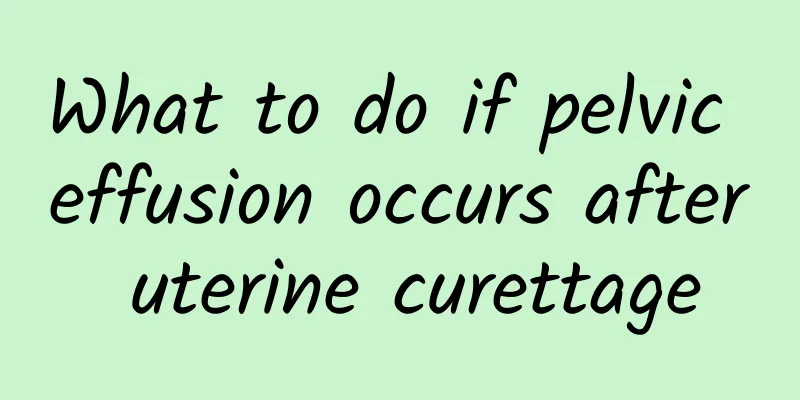What to do if pelvic effusion occurs after uterine curettage

|
Curettage is a traditional artificial abortion. It is very easy to get infected after the operation, so it is also easy to get infected in the pelvis and cause pelvic effusion. What should I do if pelvic effusion really occurs after curettage? Pelvic effusion is often accompanied by bilateral or unilateral lower abdominal pain, lumbosacral pain, backache, lower abdominal distension, pain, backache, etc., or due to long-term standing, overwork, sexual intercourse, or premenstrual aggravation, severe cases affect work. Or lower abdominal pain, or increased leucorrhea, menstrual disorders, heavy menstrual blood, dysmenorrhea, sexual discomfort; patients feel very uncomfortable and should be treated immediately and actively until the effusion is absorbed and dissipated. Therefore, if pelvic effusion occurs after uterine curettage, you should go to the hospital for treatment immediately to prevent the infection from worsening. There are several ways to treat pelvic effusion in hospitals, but the situation is usually not very serious, because it is also after surgery, it is not advisable to undergo surgery again, so surgical treatment is usually not used in the treatment plan of pelvic effusion. Instead, several other methods are used: 1. Traditional Chinese medicine treatment It mainly clears away heat and toxic substances, cools blood and relieves inflammation, and then mainly promotes qi and blood circulation, softens and disperses nodules, and breaks up blood stasis and promotes new growth. "Fuliangfang Pelvic Inflammation Patch" has comprehensive functions such as promoting qi and blood circulation, softening and dispersing nodules, eliminating latent diseases, improving local microcirculation, and maintaining normal physiological metabolism of the human body. 2. Western medicine treatment Antibiotics are the main treatment for infection, and surgery is performed when necessary. Broad-spectrum antibiotics are selected based on experience to cover possible pathogens, including Neisseria gonorrhoeae, Chlamydia trachomatis, Mycoplasma, anaerobic bacteria, and aerobic bacteria. 3. Other drug treatments When using anti-inflammatory drugs, you can also use 5 mg of α-chymotrypsin or 1500 U of hyaluronidase at the same time, injected intramuscularly once every other day, 5 to 10 times as a course of treatment, to facilitate the absorption of adhesion and inflammation. At the same time, you should pay attention to personal hygiene to avoid being infected with other diseases again. |
<<: How to prevent uterine prolapse
>>: How long does it take for abdominal pain to start in ectopic pregnancy?
Recommend
The main aspects of women's self-diagnosis of ovarian cysts
What are the main aspects of self-diagnosis of ov...
How to diagnose adenomyosis
How to diagnose adenomyosis? 1. Ultrasound examin...
Analyze the early symptoms of cervicitis for you
Cervicitis is a major disease that many women are...
What ointment should be used for leukoplakia of the vulva of menopausal women? What is the cause of white discharge from the lower body during menopause?
As they age, women tend to go through menopause, ...
Why do men with irregular menstruation prefer fat women?
With the improvement of living standards, people&...
How to eat to avoid sarcopenia? Nutritionist: Take four doses to supplement vitamin D and high-quality protein
In recent years, Taiwan's aging trend due to ...
What are the common causes of recurrence of pelvic inflammatory disease?
What are the common causes of pelvic inflammatory...
How to treat moderate cervicitis
How to treat moderate cervicitis? 1. Drug treatme...
How is pelvic inflammatory disease transmitted?
What is the transmission route of pelvic inflamma...
The best time to do painless abortion
What is the best time period for abortion? This i...
It is necessary to understand the symptoms of vaginitis
Experts say that through the symptoms of vaginiti...
How much does it cost to have an abortion ten days into the pregnancy? Can I have a medical abortion ten days into the pregnancy?
There are many female friends who do not take pre...
What is the name of the disease? What is the name of the disease?
What is the name of the disease of uterine fibroi...
Nutrition without burden! DIY celery fried chicken light lunch box, only 400 calories
【Bento side dishes: Stir-fried chicken with celer...
How should patients with Bartholinitis use medication during treatment?
What should patients with Bartholinitis use durin...









